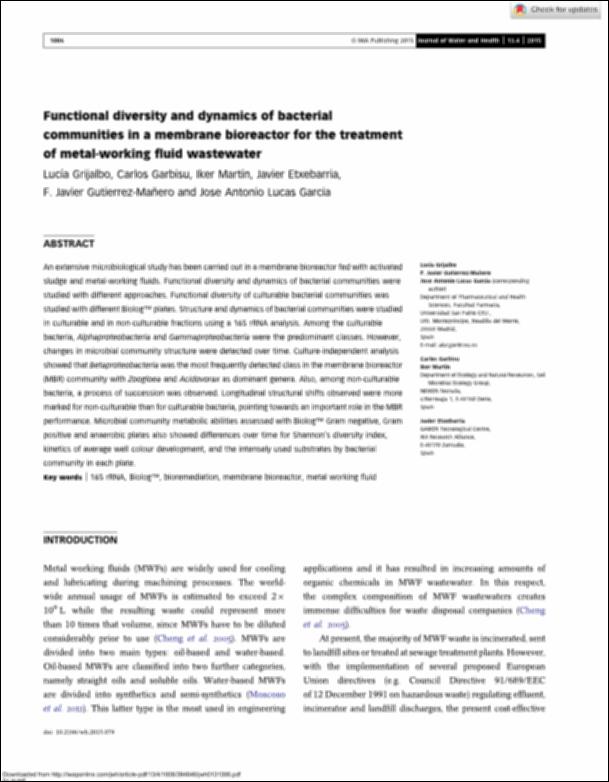Please use this identifier to cite or link to this item:
http://hdl.handle.net/10637/15982Functional diversity and dynamics of bacterial communities in a membrane bioreactor for the treatment of metal-working fluid wastewater
| Title: | Functional diversity and dynamics of bacterial communities in a membrane bioreactor for the treatment of metal-working fluid wastewater |
| Authors : | Grijalbo Fernández, Lucía Garbisu, Carlos Martín, Iker Etxebarria, Javier Gutiérrez Mañero, Francisco Javier Lucas García, José Antonio |
| Keywords: | Bioremediation; Membrane bioreactor; Metal working fluid |
| Publisher: | IWA Publishing |
| Citation: | Lucía Grijalbo, Carlos Garbisu, Iker Martín, Javier Etxebarria, F. Javier Gutierrez- Mañero, Jose Antonio Lucas Garcia; Functional diversity and dynamics of bacterial communities in a membrane bioreactor for the treatment of metal-working fluid wastewater. J Water Health 1 December 2015; 13 (4): 1006–1019. doi: https://doi.org/10.2166/wh.2015.079 |
| Abstract: | An extensive microbiological study has been carried out in a membrane bioreactor fed with activated sludge and metal-working fluids. Functional diversity and dynamics of bacterial communities were studied with different approaches. Functional diversity of culturable bacterial communities was studied with different Biolog™ plates. Structure and dynamics of bacterial communities were studied in culturable and in non-culturable fractions using a 16S rRNA analysis. Among the culturable bacteria, Alphaproteobacteria and Gammaproteobacteria were the predominant classes. However, changes in microbial community structure were detected over time. Culture-independent analysis showed that Betaproteobacteria was the most frequently detected class in the membrane bioreactor (MBR) community with Zoogloea and Acidovorax as dominant genera. Also, among non-culturable bacteria, a process of succession was observed. Longitudinal structural shifts observed were more marked for non-culturable than for culturable bacteria, pointing towards an important role in the MBR performance. Microbial community metabolic abilities assessed with Biolog™ Gram negative, Gram positive and anaerobic plates also showed differences over time for Shannon's diversity index, kinetics of average well colour development, and the intensely used substrates by bacterial community in each plate. |
| URI: | http://hdl.handle.net/10637/15982 |
| Rights : | http://creativecommons.org/licenses/by-nc-nd/4.0/deed.es Open Access |
| ISSN: | 1996-7829 |
| Issue Date: | 15-Jun-2015 |
| Center : | Universidad San Pablo-CEU |
| Appears in Collections: | Facultad de Farmacia |
Items in DSpace are protected by copyright, with all rights reserved, unless otherwise indicated.


